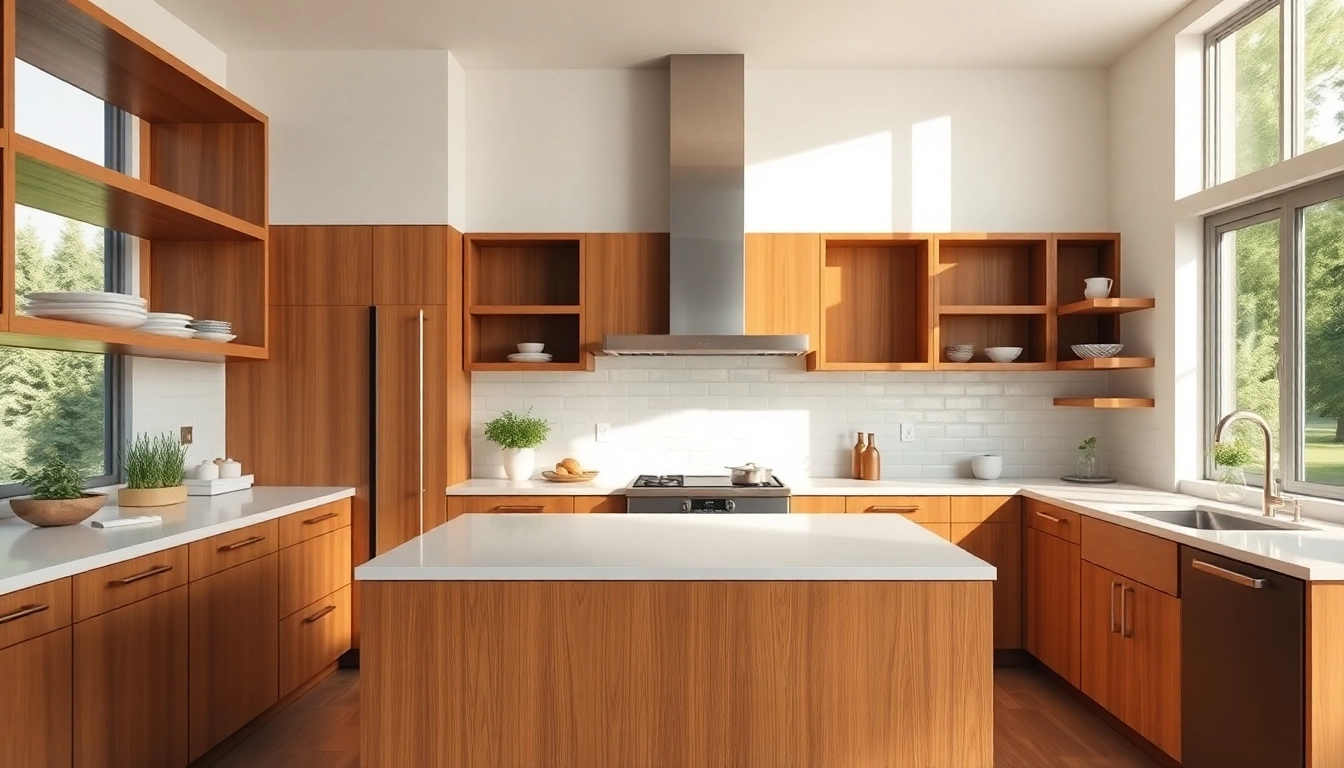Understanding Kitchen Remodels
The kitchen is often considered the heart of the home, where families gather, meals are prepared, and memories are made. As such, it’s not surprising that many homeowners invest significantly in kitchen remodels. This comprehensive guide will delve deeply into what kitchen remodels entail, the planning process, common challenges faced, budgeting expectations, design styles, the DIY vs. professional debate, and how to measure success after your remodel.
What Constitutes a Kitchen Remodel?
A kitchen remodel can involve various updates, ranging from minor aesthetic changes to major structural alterations. Essentially, it is the process of configuring the space anew, which can involve:
- Changing the layout: This includes moving countertops, cabinets, and appliances to improve functionality and flow.
- Upgrading fixtures: Swapping out old faucets, sinks, and lighting can dramatically change a kitchen’s look.
- Replacing cabinetry: New cabinetry can not only enhance aesthetics but also improve storage capabilities.
- Updating surfaces: Countertops, backsplashes, and flooring play crucial roles in both functionality and design.
In summary, any change that enhances the kitchen’s usability or aesthetic appeal can be classified as a remodel.
Planning Your Kitchen Remodel Journey
Successful kitchen remodeling begins with a well-structured plan. Here are critical steps to consider:
- Define your goals: Are you looking to increase functionality, enhance aesthetics, or boost property value?
- Establish a timeline: Understand the scope of the project to set a realistic timeline.
- Research design ideas: Explore various design styles and functionalities that resonate with your lifestyle.
- Create a budget: This will allow you to prioritize needs versus wants and mitigate cost overruns.
Every project is different, so adapting this process to fit your specific needs can yield the best results.
Common Challenges in Kitchen Remodels
Despite meticulous planning, homeowners often encounter obstacles during kitchen remodels. Typical challenges include:
- Delays: Unforeseen delays can arise from material availability, contractor schedules, or structural issues.
- Budget Overruns: Costs can spiral if there are unexpected complications or changes in the scope of work.
- Design Conflicts: Alignment among homeowners’ visions, contractor expertise, and new design trends can sometimes clash.
To navigate these challenges, communication with all parties involved is key, along with flexibility in planning.
Budgeting for Your Kitchen Remodel
Budgeting is a fundamental aspect of any kitchen remodel. Understanding your financial commitments can prevent awkward surprises down the line.
Realistic Cost Expectations for Kitchen Remodels
The cost of a kitchen remodel can vary significantly based on location, the scope of the project, and material selections. For most homeowners, a medium-large kitchen remodel falls between $32,574 to $77,939. It’s essential to note several factors influencing these costs, including:
- Geographic location: Labor costs and material availability can vary dramatically depending on your area.
- Home value: Your budget should align with the property’s market value to ensure a good return on investment.
- Project scope: The more extensive the remodel, the higher the costs. Minor updates will be more budget-friendly than a full remodel.
Smart Budgeting Tips for Kitchen Remodels
Effective budgeting requires strategic planning. Here are practical tips:
- Consult professionals: Getting estimates from contractors will help in understanding the market rates.
- Prioritize needs over wants: Distinguish between essential improvements and desired luxury upgrades.
- Set aside contingency funds: Ideally, reserve 10-20% of your overall budget for unforeseen expenses.
Cost-Saving Strategies During a Kitchen Remodel
Cost management is crucial in kitchen remodels. Implement these strategies to save money:
- DIY projects: Consider handling minor tasks such as painting or hardware replacement.
- Refurbish instead of replace: Refinishing existing cabinets can offer a fresh look without the cost of new ones.
- Shop small: Sometimes, sourcing materials at local suppliers or online marketplaces can be more economical than big-box retailers.
Design Styles for Kitchen Remodels
The design of a kitchen can heavily influence its atmosphere and functionality. Understanding various styles can provide inspiration for your project.
Popular Trends in Kitchen Remodels
Stay updated on trending kitchen designs to ensure modernity in your remodel. Current popular trends include:
- Open floor plans: Integrating kitchen spaces with living areas fosters a sense of inclusivity.
- Smart technology: Features such as smart refrigerators and automated lighting systems add functionality.
- Eco-friendly materials: Sustainable materials and energy-efficient appliances are gaining traction.
Choosing the Right Materials for Your Kitchen Remodel
The materials selected greatly affect both the aesthetics and functionality of the kitchen. Here are significant considerations:
- Countertops: Popular choices include granite, quartz, and butcher block, each offering unique benefits.
- Flooring: From hardwood to tile, the choice must complement both design and durability considerations.
- Cabinets: Explore various materials, from solid wood to MDF, and decide based on style and budget.
Incorporating Functionality into Your Kitchen Remodel
Beyond aesthetics, consider these functional aspects:
- Storage solutions: Utilize creative storage like pull-out shelves, deep drawers, and corner cabinets.
- Work zones: Designate specific areas for cooking, cleaning, and food prep to enhance workflow.
- Lighting: Ensure proper lighting for all areas, using a mix of ambient, task, and accent lighting.
DIY vs. Professional Kitchen Remodels
Choosing between DIY and professional help often depends on the project scope, budget, and personal skills. Understanding the pros and cons of both can guide decision-making.
When to Hire a Pro for Your Kitchen Remodel
While many tasks can be DIY-friendly, specific aspects warrant professional involvement, including:
- Electrical and plumbing work: These require skilled labor and often permits, making it safer to hire professionals.
- Custom cabinetry: Designing and installing custom cabinets often requires specialized knowledge.
- Structural changes: Any alterations involving walls or load-bearing structures should be left to experts.
Evaluating DIY Projects in Kitchen Remodels
Undertaking DIY tasks can lower costs and provide a sense of personal achievement. However, it’s essential to evaluate your capabilities honestly:
- Skills assessment: Understand what parts of the project you can handle comfortably versus what requires specialized knowledge.
- Time commitment: Ensure you have the time to dedicate to the project, as some tasks can be time-consuming.
- Quality expectations: Be realistic about the quality of the work, knowing that professionals often have the skill and tools to achieve better outcomes.
Resources for DIY Kitchen Remodels
Explore these resources for DIY guidance:
- YouTube tutorials: Many channels offer comprehensive guides on everything from tiling to cabinet installation.
- Home improvement forums: Platforms like Reddit or DIY Network provide community support and advice.
- Books and magazines: Explore home improvement publications and resources dedicated to kitchen projects.
Measuring Success After Your Kitchen Remodel
After your kitchen remodel is complete, measuring the success of the project can validate the effort and investment.
Key Metrics for Evaluating Kitchen Remodels
Consider these metrics to evaluate the success of your remodel:
- Functionality: Post-remodel, does your kitchen meet the daily needs of your household?
- Aesthetic appeal: Are the new designs and materials aligned with your vision and taste?
- Increased value: Has your property’s market value improved as a result of the remodel?
Gathering Feedback Post-Kitchen Remodel
Seek feedback from family and friends who use the kitchen regularly. Their insights can reveal both successes and potential areas for improvement.
Creating Maintenance Plans for Your Kitchen Remodel
Once your kitchen is remodeled, establishing a maintenance plan ensures it remains functional and beautiful. Consider these steps:
- Regular cleaning schedules: Maintain cleanliness to extend the life of your surfaces and fixtures.
- Periodic checks: Schedule inspections for plumbing and electrical systems to avoid potential issues.
- Routine upgrades: Stay mindful of trends and technology to enhance the kitchen slowly over time.
In conclusion, a kitchen remodel is a significant undertaking that can enhance both the function and aesthetic of your home. By understanding the planning process, budgeting wisely, and leveraging design trends, you can create a kitchen that fits your needs and lifestyle. Whether opting for a DIY approach or hiring professionals, thorough research and preparation will lead to a successful outcome.


